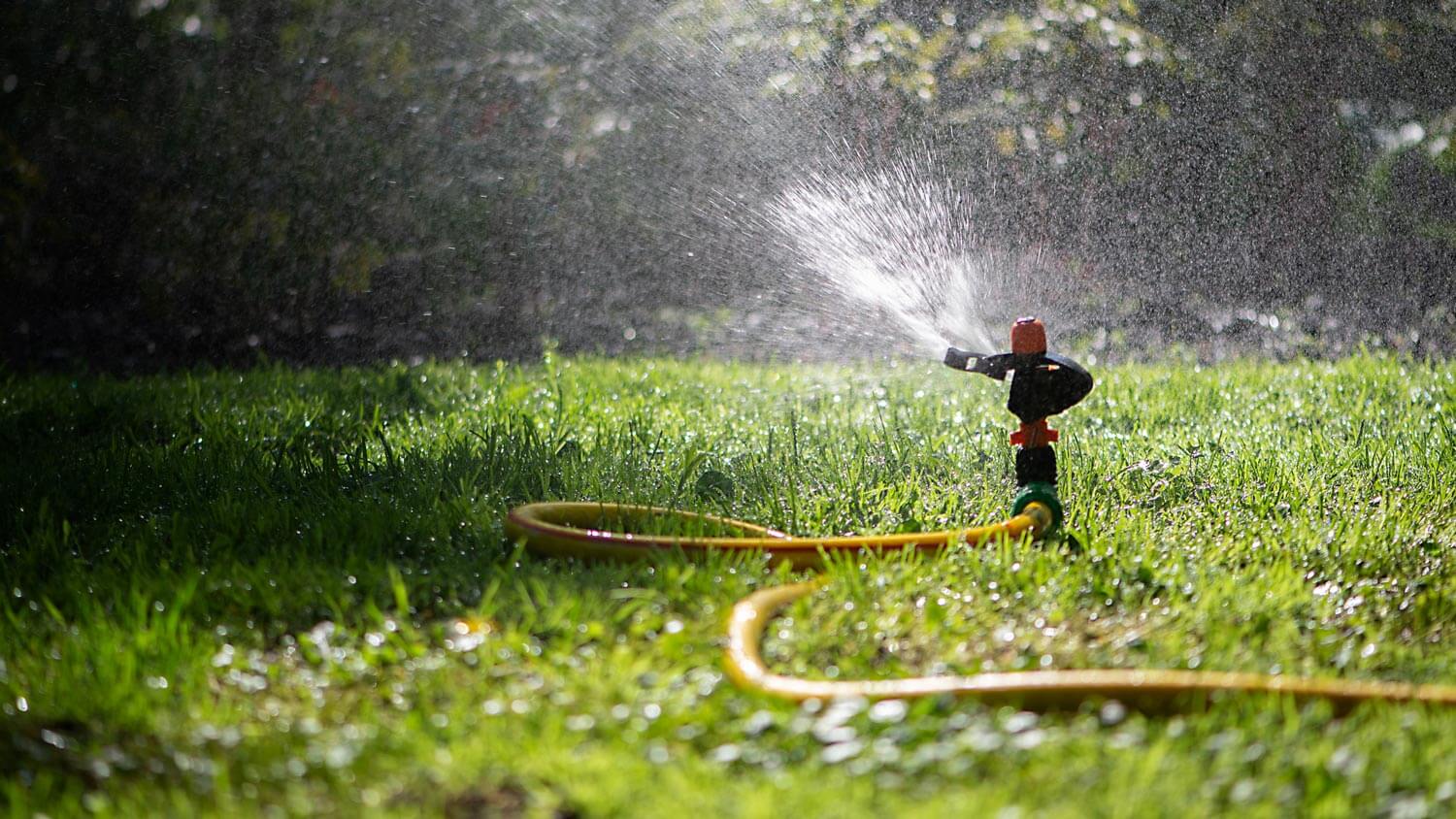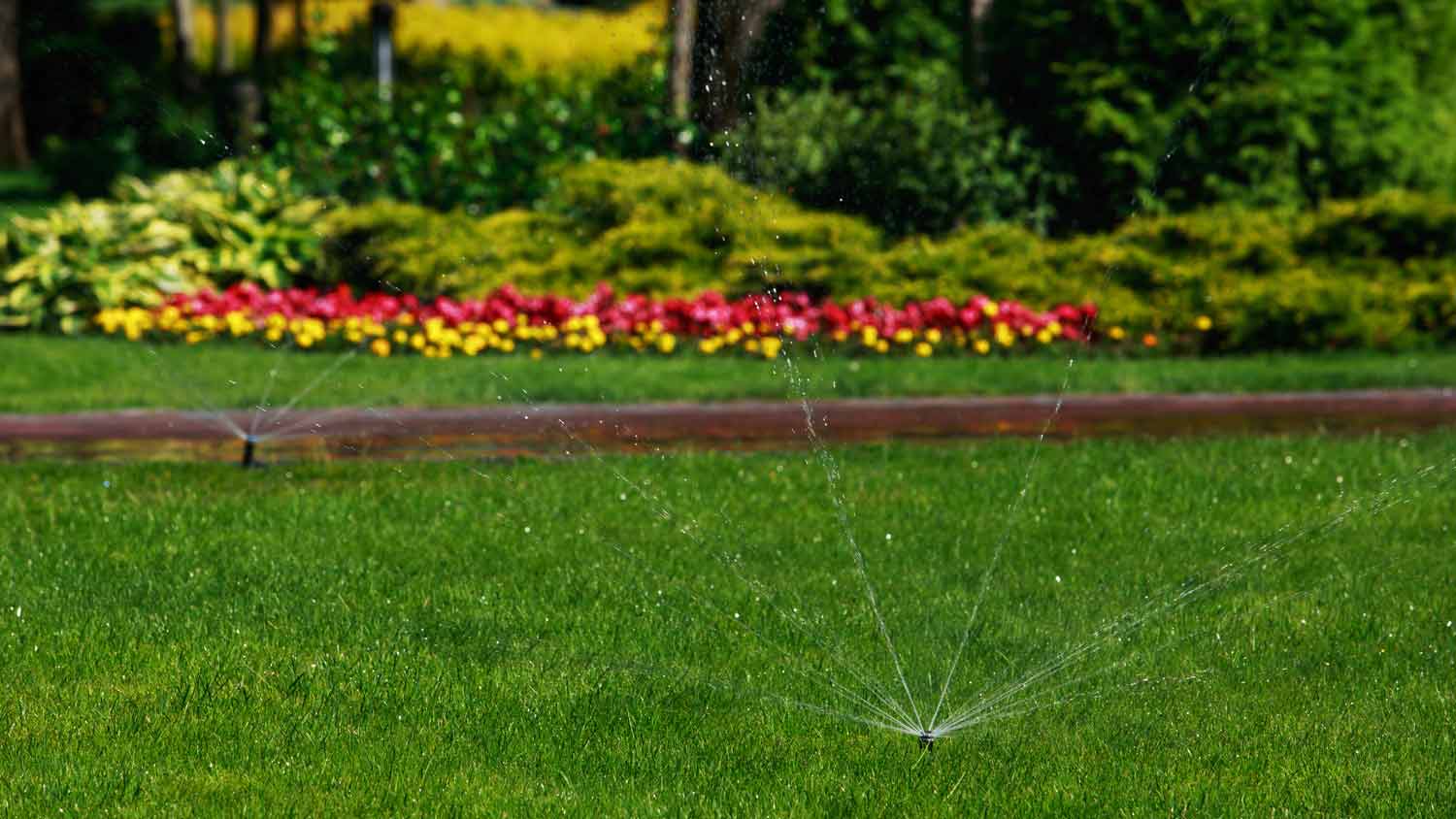How To Turn on a Sprinkler System in 11 Simple Steps
Because sometimes those April showers just aren’t enough to keep your lawn green


- Sprinkler valve key (for some systems)
- Flathead screwdriver
- Pliers (for some systems)
- Pencil
- Notebook or paper
With robins appearing on the windowsill and winter finally behind you for good, it's time to dream of warmer and greener days ahead. In other words, it’s time for your sprinkler system to come out of hibernation. If you decide to forgo your annual sprinkler turn-on service, it's important to fully understand how to do the job DIY without causing damage. This guide will show you how to turn on a sprinkler system in 11 simple steps.
When to Turn on Your Sprinkler System in Spring
Before you turn on your sprinkler system in the spring, you need to make sure that your timing is right. If the ground is still frozen, it could damage sprinkler components, leading to a costly sprinkler repair. If you’re not sure, dig about a foot into the ground. If it’s frozen, wait for more consistently warm weather. Only turn on your sprinklers after the last frost. The farmer’s almanac should have a rough estimate.
When you finally turn on your sprinkler system, make sure you turn it on slowly. The velocity of the water can damage pipes and sprinkler heads.
Inspect for Damage
Even if you properly winterized your sprinkler system, sprinkler heads, valves, and pipes face harsh elements in the colder months. You need to inspect for winter damage. Walk through your yard to remove debris or dirt from sprinkler heads, and inspect the pipes, valves, and related mechanisms around your main valve, drain valves, and backflow preventer. Keep in mind that the smallest amount of frozen water left in the system can lead to cracks, so you may not detect issues until you're ready to turn it on.
Find the System’s Main Shut-Off Valve
Before you can turn on your sprinkler system, you need to find the sprinkler shut-off valve. The valve is found in the crawl space, basement, or utility room. You can find it attached to copper pipes that lead into the home at ground level but not below. If not, you can find it in your sprinkler control box.
Be careful not to confuse your sprinkler shut-off valve with the shut-off valve for your home’s main water line. That one typically comes from below ground level, and you don’t need to interact with it for this project. If you aren’t sure, this guide can help you identify your home’s main water shut-off.
Find the Vacuum Breaker
The vacuum breaker, which is a type of backflow preventer, is usually located above ground and close to your house. Look for a copper or plastic valve assembly connecting two pipes. These pipes should each have a shut-off valve.
Close the Vacuum Breaker Test Valves
Your vacuum breaker has two test valves—not to be confused with the shut-off valves. Instead of a lever or butterfly handle, the test valves have a slot for a flathead screwdriver. Use your screwdriver to turn these valves 45 degrees so they’re perpendicular to the stem where they’re attached rather than parallel.
Open the Vacuum Breaker Shut-Off Valves
In addition to the test valves, your vacuum breaker has two shutoff valves—one on each pipe connected to it. The valves have a handle that looks like a lever or butterfly. Open each valve by turning the handle parallel to its respective pipe.
Reinstall the Main Valve Bleeder Cap
Your vacuum breaker may have a metal cap that’s meant to cover the bleeder nipple on the side of the shut-off valve. The point of the bleeder nipple is to drain residual water when you shut down the system for the winter. If you do have a cap, screw it in place.
Carefully Open the Main Valve
 Photo: Zelma Brezinska / EyeEm / EyeEm / Getty Images
Photo: Zelma Brezinska / EyeEm / EyeEm / Getty ImagesNow it's time to—very slowly—open the main valve to your irrigation system. Open the valve by only turning it a part of the way. With each small turn, wait several minutes to hear the pipes fill properly. If you move too quickly, you can cause the water to rush the system too quickly, causing what's known as a water hammer—or a shock of water that’ll send your sprinkler heads flying. After several turns, ensure the valve is fully open and parallel to its pipe.
Run a Manual Test
With the water at the ready, run a test manually from your control panel for each irrigation zone. Watch and listen to the sprinkler heads for any issues before moving on to the next one. While the sprinkler head may take a moment to flow freely, it shouldn't sputter after a few minutes. Keep your eye out for water pooling in one area or coming up from under the ground through a potentially burst pipe.
After cycling through each zone, re-check your valves and water main pipes in the basement to ensure everything is still intact and tightened.
Check the Vacuum Breaker and Valves
Check your system to make sure there aren't any leaks. Open each valve box and inspect the inside. Check around the main valve and vacuum breaker valves, as well as around visible piping and sprinkler heads. Use pliers to tighten the bleeder cap if it’s leaking.
Troubleshoot Issues
If you noticed any issues during your manual test and inspection, troubleshoot what you can. You may be able to adjust the watering pattern, but if you need to start replacing parts like broken sprinkler heads, call your local irrigation repair specialist. A broken sprinkler system wastes water, can cause water damage to your landscape and foundation, and can wear down your current system.
Set Up Your Timer and Go
You've done your due diligence, and your sprinkler system is up, running, and ready to go. Now it's time to customize its setting to avoid water waste and overwatering different parts of your landscape. Set your timer for the first watering. Check it when it turns on just to make sure it’s working properly. From there, you can set your watering schedule to whatever is best for your lawn and garden.
Turning on a Sprinkler System DIY vs. Hiring a Pro
Sprinkler systems are complex. It may not be difficult to turn one on, but if you’re not familiar with your specific sprinkler system, you should hire a professional lawn irrigation service to turn on your sprinkler system. If you’re going the DIY route, always use care and caution to avoid injury or damage to the system.
Winter can wear down the individual parts of an irrigation system, and you want to catch the problem before it spirals into a serious issue like a flooded foundation. If you have any doubts, contact a sprinkler repair service near you.
Your local municipality may also require an annual backflow preventer inspection. This tiny device attaches to your water supply and ensures that contaminated water doesn’t flow back into your system, where it could potentially end up in the tap you drink.
Frequently Asked Questions
After hiring a pro to winterize your sprinkler system, it's best to let the pro open it back up for the spring. However, if you feel confident about the parts of your water valve, backflow preventer, and vacuum breaker, you can turn your sprinkler system on in less than an hour.
In order to turn on your sprinkler system in the winter, you’ll need to:
Find the system’s main shut-off valve
Locate the vacuum breaker
Close the test valves on the vacuum breaker
Open the shut-off valves on vacuum breaker
Reinstall the bleeder cap on the main valve
Open the main valve slowly so as to not shock the system
Test the system to make sure it’s working properly
It’s also important to make any repairs if you notice leaks or malfunctions during the set-up process.
The valve is usually in a crawl space, basement, or utility room. It’s typically attached to copper pipes that lead into the home at ground level—not below. If not, you can find it in your sprinkler control box. Consult a sprinkler professional if you have difficulty finding or operating your sprinkler shut-off valve.















